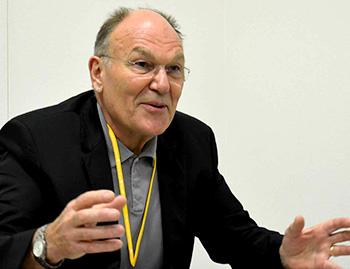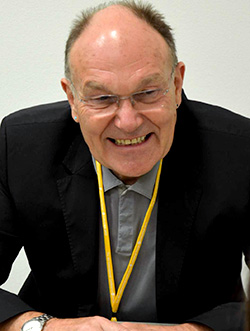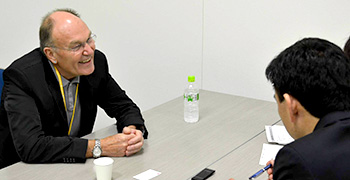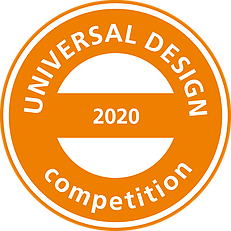2010.07.12
Japan has progressed UD for the last decade in that public and private sectors have been working together and tackling.
2013.04.14 Updated

Roger Coleman
Professor Emeritus, Royal College of Art: UK
Interviewer: Hideki Akiya (Toyota Boshoku Corporation)
Interview date: Oct. 12, 2012 AM 10:50-
— First of all, next year, it will have been 10 years since IAUD was established in 2003. What do you think of the progress of Japanese universal design in the last 10 years?
Roger Coleman: I am very impressed. It’s a great moment to have a 10th birthday. I’m very impressed because in my view Japan as a country, as a nation, has taken this more seriously than any other country that I know. What I can see is that there’re different drivers for universal design in different countries. For example, in America, legal and political systems play a large role; they decided to push universal design by obeying laws. America is much less organized as a society than Japan is. It’s much harder, in a way, to get people to behave, to get to work together in America. Legislation is an obvious route to take.
In the Scandinavian countries where they’ve got a strong sense of social welfare, universal design has been driven by a desire for social welfare, to improve social welfare by making things accessible basically. There’s a strong tradition of inclusive design in Scandinavia as well, which has shaped in a different way what has happened. There’ve been great examples of product designs and of the design of things like Undergrounds and so on that have come out of Scandinavia.
In Europe, the concern has been more to ensure to build a cohesive Europe. Social cohesion is the biggest issue in Europe. Social inclusion has been the driving force in Europe.
In the UK, progress has been patchy in the UK, I feel, because we struggle to get the government fully behind the idea. We also have run an inclusive design management but we don’t really have a government minister responsible for the area.
My feeling is that in Japan there was a gestation period from 2002 for perhaps the first 4 years where people thought about it and tried to see and think about what should be done, and then gradually things started to happen. I know that in Japan there were precursors to that. The work of the Ministry of Housing had made very good foundations for this, and then we have companies like Sekisui as well, who would look to what was going on in the rest of the world and started to bring these ideas into Japan. Lifetime housing was actually an idea that originated in the UK, but never really took off in the UK. But in Japan, Sekisui has made it their special unique offering and has developed it extremely well. I see much more collaboration. What I admire about Japan, and I think it’s very special is the way in which ministries, government organizations, local authorities, municipal government, and major companies and NGOs are all working together. I don’t see that anywhere else in the world, that collaboration across the society.
I don’t know but I think the fact that the late Prince Tomohito led the organization was important in that regard in bringing the nation together around the idea. The other thing I see that is important is that people like the late Yamamoto-san, the former head of IAUD who we lost in January and Toda-san from Panasonic, who’s speaking today; leadership from that high up in the major companies is terribly important; it really does make a difference.
The other thing that I think is very special about Japan is the emphasis that I’ve seen, I almost talked about this morning on the universal cities, on thinking in terms of major transport interchanges help people access cities; so how you can get from outside into the city and then communicate to all the areas in the city that is very special.
— How do you feel about what is our Japanese role to progress universal design in Asian area?
Roger Coleman: I think it's yet to be developed. I felt for a long time that Japan is doing very well internally, and it needs to start to export the ideas and be more confident about what has been achieved here. Because I was at the first meeting in 2002, I've seen the progress and I keep thinking this is very special. It really is a fantastic platform on which to put forward some of those ideas that are very strong in Japan, which I think are very important, which are about collective action and about our shared responsibilities. I see the Japanese role in promoting UDNA is really something which is just starting.
I think Japan has a big part to play not in a sort of empire building sort of a way but in the sharing success. I think there are success stories to be shared. The challenge is to translate them into ways that work for other cultures and in other parts of the world that are perhaps less prosperous than Japan.
 For me, the whole project of universal design, inclusive design, whatever you call it, is really about understanding that we share the same planet. We have to work together and we have to make it possible for everybody to develop as fully as they possibly can. Those are the reasons it’s a collective action for mutual benefit. I think that’s very much in the Japanese mindset.
For me, the whole project of universal design, inclusive design, whatever you call it, is really about understanding that we share the same planet. We have to work together and we have to make it possible for everybody to develop as fully as they possibly can. Those are the reasons it’s a collective action for mutual benefit. I think that’s very much in the Japanese mindset.
I think disasters like the Great Eastern Earthquake, terrible though they are, if they help us react in that collective way then we can benefit from them.
I see this conference and this moment as a great opportunity to go beyond working together and really starting to share experiences from different sectors and understand better the way different sectors, be it government or industry or design, or be it other industrial areas like aviation and road transport; how they approach and think about this sort of common problems that we have to share their experience.
— I think we Japanese and many people who live in Asia have changed our sense of security since Japanese met the tragic earthquake and tsunami last year. Now we have two points: first is saving our life from the future natural disaster; second, getting back our safety daily life after disaster. These two issues are very serious problems for us. Then, I have a third question. What do you think of how do we have to do to realize sustainable society in terms of saving life and recovering our daily safety life after disaster?
Roger Coleman: I’ve always felt that when we talk about the sustainable design — I’ve always felt we have to move beyond the environment because unless you’ve got sustainable communities, sustainable societies, it’s very hard to have a sustainable environment. I feel that the progress that we’ve made so far with Universal Design has been very much about sustainable communities; universally accessible cities are sustainable cities at a human level. We’ve already — so bringing together green design, environmental design, and universal design is very important. Adding ideas of safety and security is a third thing to look at, and I think it lifts Universal Design up to a higher level. It’s a higher level really that we’ve yet to explore.
If I can put it in a different way, I think people started of thinking about – the term Universal Design originated in America. It was an aspirational demand from disability organizations; everything should be accessible to everybody. If you talked to people in those early days, they were just thinking about wheelchairs and barrier-free; and wheelchair, barrier-free problem sorted. What we have learned is that it’s not as simple as that. We’ve learned that we’ve to think in a much bigger way. If we’re going to make things genuinely universal, and we’ve got to make them appealing to people, we’ve got to make them things that everybody can understand not just them. That was a big learning curve for everybody I think. And then, we had to start thinking about sustainable communities, and so each time we had to step up the thinking. As far as safety and security is concerned, I think we’re back down at the barrier-free level. I hope that this conference is a start of being able to think about – we’ve got ideas; we’re being able to think about Universal Design in a different way.
I can’t really talk about the awards at the moment because we have got to wait, but I have seen some very interesting entries that show some directions that we can take. Once they’ve been announced that’ll be great. When we looked at them we had to decide that there should be a category for the awards, I think I can say this now, which was for daily use and emergency use. Looking at products in particular that have a double use that can be used differently in an emergency situation. That duality about what they can be used for will become very important. I think there were very, very interesting things that this is going to throw up. In addition, if you think how do we make our life safer, it means we actually have to make our lives simpler. We can’t make them more complicated. These making things simpler I think is going to become a part of how we deal with these issues.
Again, I think this will be very interesting in Japan because there is part of the Japanese aesthetic, and also the fact that lots of people are living in small spaces means that you have to make things simpler in Japan. I think we’re in a moment of real tension between all the things that we have; all the gadgets and things that we have; the complexity of life and actually a need for simplicity, an emotional sort of mental aesthetic need for simplicity. All of that stuff that we’re making is not good for the environment anyway. It seems to me this is an opportunity to rethink in kind of deep way these issues about complexity and simplicity.
 If I’ve got a few more minutes and I can use one more analogy. If you think about very early nomadic societies, people had to carry everything with them. In a way, they had to compress everything; their whole culture, everything that they needed into a small space to carry up with them. That was the origins of our modern sense of aesthetics, I think, in that you didn't just have a car; it would be decorated and you’d be able to read that decoration as part of your history, or it would be every object would have to be able to tell a story. From our very early origins, we had to be able to embed objects with layers of meaning. I think we need to find ways to return to that of making less more. Actually, I think it’s very much within our psyches as human beings to do that. I think we’ll find very interesting and exciting ways to do it.
If I’ve got a few more minutes and I can use one more analogy. If you think about very early nomadic societies, people had to carry everything with them. In a way, they had to compress everything; their whole culture, everything that they needed into a small space to carry up with them. That was the origins of our modern sense of aesthetics, I think, in that you didn't just have a car; it would be decorated and you’d be able to read that decoration as part of your history, or it would be every object would have to be able to tell a story. From our very early origins, we had to be able to embed objects with layers of meaning. I think we need to find ways to return to that of making less more. Actually, I think it’s very much within our psyches as human beings to do that. I think we’ll find very interesting and exciting ways to do it.
I think you’ve to think deep about these things. In the early days, people started thinking about universal design and making supposedly universal design products, which were really disability aids. You sort of got to the point where you might say to someone, would you like the universal design one or would you like the pretty one? There was a conflict between and we realized we have got to make the universal design one attractive. In other words, it had to fit our psyches. I think we have learned that. I think actually addressing issues of safety and security will be difficult, it will be challenging but we’ve already made progress in a lot of ways. We will come up with solutions that we’ll make desirable and things that people will – we won’t make the same mistakes, or we won’t make all of the same mistakes.
— Thank you very much.
Inquiries
![]() Please make your inquiry here (you will be automatically transferred to the Inquiries page).
Please make your inquiry here (you will be automatically transferred to the Inquiries page).






![[Global Interview 2016] It would be very appreciated if Japan or IAUD could provide and share information and strategies to Europe. 画像](https://www.iaud.net/file/en/sites/3/03bade-1-320x289.jpg)
![[Global Interview 2016] It will be wonderful if the first-ever united Games of the Olympics for non-handicapped people and the Paralympics for handicapped people is realized in Japan in 2020. 画像](https://www.iaud.net/file/en/sites/3/04balaram-1-320x172.jpg)
![[Global Interview 2016] It will be great if the year 2020 becomes a good opportunity for the whole society to raise awareness of design, thereby changing the society for the better. 画像](https://www.iaud.net/file/en/sites/3/01wessler-1-320x279.jpg)
